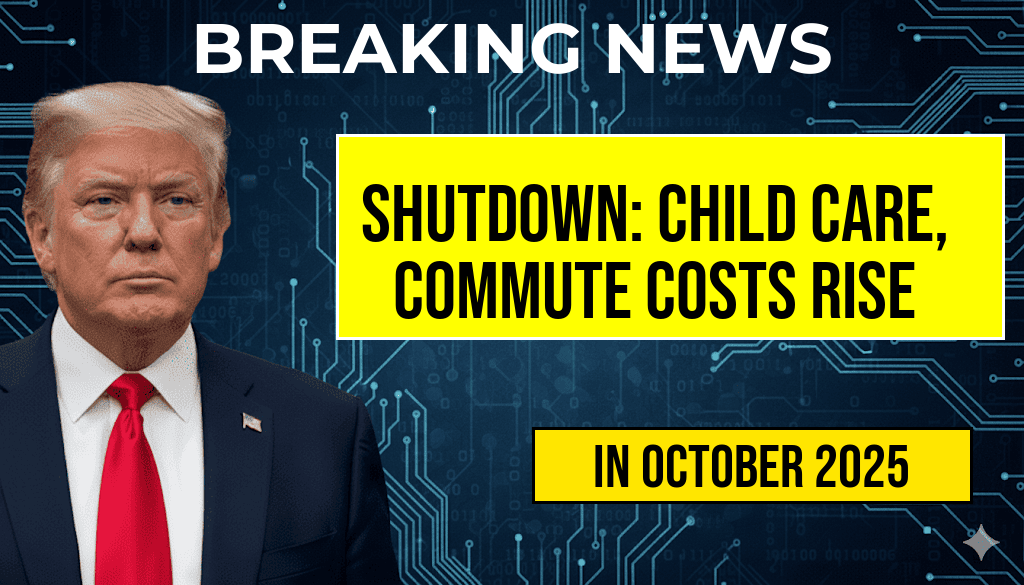The ongoing government shutdown is having significant repercussions on daily life in the Washington, D.C. region, with many families experiencing a sharp decline in available child-care slots and commuters facing heightened transportation costs. As federal services remain suspended, child-care centers that rely on federal funding are being forced to close their doors, leaving parents scrambling for alternatives. Simultaneously, the shutdown has led to an increase in commuting expenses due to rising public transportation fares and longer travel times. These developments are prompting concerns among residents who depend heavily on both child care and reliable transportation in their daily routines.
Impact on Child Care Services
Child care facilities across the D.C. area are feeling the strain of the government shutdown. Many centers that receive federal funding or grants have reduced their operating hours or shut down entirely. As a result, parents are facing a shortage of available slots, forcing them to seek alternative arrangements that may not meet their needs or budget.
Statistics on Child-Care Availability
According to a recent report from the Child Care Aware, the D.C. region has lost approximately 20% of its child-care slots since the onset of the shutdown. This figure reflects closures in both private and public facilities, making it increasingly challenging for working families to find adequate care for their children.
- 20% decrease in available child-care slots in D.C.
- 50% of providers report financial instability due to funding interruptions.
- 30% of parents have had to adjust their work schedules to accommodate child-care shortages.
Rising Commute Costs
The shutdown has also affected public transportation costs in the D.C. area. With a surge in demand for alternative commuting methods due to increased traffic and longer travel times, local transit authorities have raised fares on several routes to manage the additional strain on services. Commuters are left to navigate the financial burden of higher fares alongside the logistical challenges presented by service delays.
Public Transportation Changes
Metro and bus services have reported delays averaging 15 to 25 minutes, significantly impacting the daily commute for thousands of workers. The fare increases, while intended to cover operational costs, are prompting frustration among riders who are already feeling the effects of the shutdown.
| Service | Previous Fare | New Fare | Percentage Increase |
|---|---|---|---|
| Metro Rail | $2.50 | $3.00 | 20% |
| Metro Bus | $1.75 | $2.00 | 14% |
Community Response and Resources
In response to these challenges, local organizations and advocacy groups are stepping in to provide support for families and commuters affected by the shutdown. Resources include emergency child-care programs and financial assistance for commuting costs. Community leaders are urging residents to explore these options to mitigate the impact of the current crisis.
Available Resources
The Road Ahead
As the government shutdown continues, the effects on child care and commuting in the D.C. region are expected to deepen. Families are increasingly concerned about their ability to maintain their work-life balance, while commuters face the prospect of ongoing disruptions and rising costs. The situation remains fluid, and community leaders call for swift action to address the pressing needs of residents.
Frequently Asked Questions
What are the main effects of the government shutdown on child care in the DC region?
The government shutdown has led to a significant reduction in child-care slots, making it harder for families to find affordable and available options for their children. Providers are facing funding challenges, which in turn affects their capacity to offer services.
How has the government shutdown impacted commuting costs in the DC area?
Commuting costs have surged due to the government shutdown as more people are forced to rely on public transportation and other alternative means to get to work. Increased demand for these services can lead to higher fares and longer wait times.
Are there any programs available to help families affected by the loss of child-care slots?
Yes, some local organizations and community groups are working to provide resources and support for families impacted by the loss of child-care slots. Families can reach out to local non-profits for assistance in finding alternative care options.
What should commuters do to manage increased costs during the government shutdown?
Commuters can explore carpooling options, use alternative routes, or consider flexible work arrangements to help manage increased commuting costs. Additionally, checking for any available discounts on public transportation can also provide some relief.
How long is the government shutdown expected to last?
The duration of the government shutdown is uncertain and depends on negotiations between lawmakers. It is essential for residents to stay informed through official government announcements and news outlets for updates on the situation.













